Using a Hydro-Morphic Classification of Catchments to Characterise and Explain High Flow and Overbank Flood Behaviour
Abstract
1. Introduction
- To establish whether there are statistically distinct clusters of hydrograph shapes produced during high flows and overbank floods based on kurtosis, skewness, and rate-of-rise in coastal catchments of NSW.
- To analyse the correlation between clusters of high flow and overbank flood hydrographs and catchment morphometrics to determine if there is hydrological similarity among catchments with similar morphometric characteristics.
- To determine which catchment morphometrics are dominant controls on the hydrograph shapes produced during high flows and overbank floods.
2. Regional Setting
3. Materials and Methods
3.1. Hydrological Indicators
3.2. Catchment Morphometric Measures
3.3. Statistical Analyses
4. Results
4.1. PCA and Standardisation Analysis Results
4.1.1. High Flows
4.1.2. Overbank Floods
4.2. Elbow Analysis and K-Mean Clustering Method for Representative High Flow and Overbank Flood Hydrographs
4.3. Regional- and Catchment-Scale Distribution of Different Types of Representative High Flow and Overbank Flood Hydrographs
4.4. SPCA Analysis to Identify the Mix and Dominance of Catchment Morphometric Controls on Each Flood Type Cluster
5. Discussion
5.1. Identification of Different Hydrograph Shapes, and Hydrograph Types
5.2. Identification of the Mix and Dominance of Catchment Morphometric Controls on Flood Behaviour
5.3. The Potential Application of a Hydro-Morphic Classification of Catchments
6. Conclusions
Supplementary Materials
Author Contributions
Funding
Data Availability Statement
Conflicts of Interest
References
- Horton, R.E. Erosional development of streams and their drainage basins; hydrophysical approach to quantitative morphology. Geol. Soc. Am. Bull. 1945, 56, 275–370. [Google Scholar] [CrossRef]
- Leopold, L.B.; Wolman, M.G.; Miller, J.P. Fluvial processes in geomorphology. Dover Publications, Inc.: New York, NY, USA, 1964. [Google Scholar]
- Schumm, S.A.; Lichty, R.W. Channel widening and flood-plain construction along Cimarron River in southwestern Kansas. U.S. Geol. Surv. Prof. Pap. 1963, 352-D, 71–88. [Google Scholar] [CrossRef]
- Strahler, A. Quantitative Geomorphology of Drainage Basins and Channel Networks. In Handbook of Applied Hydrology; Chow, V., Ed.; McGraw Hill: New York, NY, USA, 1964; pp. 439–476. [Google Scholar]
- Hack, J.T. Studies of longitudinal stream profiles in Virginia and Maryland. Geol. Soc. Am. Bull. 1957, 68, 124–141. [Google Scholar]
- Chorley, R.J. (Ed.) The drainage basin as the fundamental geomorphic unit. In Introduction to Physical Hydrology; Routledge: London, UK, 1969. [Google Scholar]
- Howard, A.D. Drainage analysis in geologic interpretation: A summation. Am. Assoc. Pet. Geol. Bull. 1967, 51, 2246–2259. [Google Scholar] [CrossRef]
- Gregory, K.J.; Walling, D.E. Report: Fluvial Processes in Small Instrumented Watersheds in the British Isles. Area 1973, 5, 297–302. [Google Scholar]
- Benda, L.; Andras, K.; Miller, D.; Bigelow, P. Confluence effects in rivers: Interactions of basin scale, network geometry, and disturbance regimes. Water Resour. Res. 2004, 40, W05402. [Google Scholar] [CrossRef]
- Benda, L.E.E.; Poff, N.L.; Miller, D.; Dunne, T.; Reeves, G.; Pess, G.; Pollock, M. The network dynamics hypothesis: How channel networks structure riverine habitats. BioScience 2004, 54, 413–427. [Google Scholar] [CrossRef]
- Wagener, T.; Sivapalan, M.; Troch, P.; Woods, R. Catchment Classification and Hydrologic Similarity. Geogr. Compass 2007, 1, 901–931. [Google Scholar] [CrossRef]
- Ali, G.; Tetzlaff, D.; Soulsby, C.; McDonnell, J.J.; Capell, R. A comparison of similarity indices for catchment classification using a cross-regional dataset. Adv. Water Resour. 2012, 40, 11–22. [Google Scholar] [CrossRef]
- Brunner, M.I.; Viviroli, D.; Sikorska, A.E.; Vannier, O.; Favre, A.C.; Seibert, J. Flood type specific construction of synthetic design hydrographs. Water Resour. Res. 2017, 53, 1390–1406. [Google Scholar] [CrossRef]
- Jehn, F.U.; Bestian, K.; Breuer, L.; Kraft, P.; Houska, T. Using hydrological and climatic catchment clusters to explore drivers of catchment behaviour. Hydrol. Earth Syst. Sci. 2020, 24, 1081–1100. [Google Scholar] [CrossRef]
- Singh, P.K.; Kumar, V.; Purohit, R.C.; Kothari, M.; Dashora, P.K. Application of principal component analysis in grouping geomorphic parameters for hydrologic modeling. Water Resour. Manag. 2008, 23, 325–339. [Google Scholar] [CrossRef]
- Sawicz, K.; Wagener, T.; Sivapalan, M.; Troch, P.A.; Carrillo, G. Catchment classification: Empirical analysis of hydrologic similarity based on catchment function in the eastern USA. Hydrol. Earth Syst. Sci. 2011, 15, 2895–2911. [Google Scholar] [CrossRef]
- Merz, R.; Blöschl, G. A regional analysis of event runoff coefficients with respect to climate and catchment characteristics in Austria. Water Resour. Res. 2009, 45, W01405. [Google Scholar] [CrossRef]
- Ley, R.; Casper, M.C.; Hellebrand, H.; Merz, R. Catchment classification by runoff behaviour with self-organizing maps (SOM). Hydrol. Earth Syst. Sci. 2011, 15, 2947–2962. [Google Scholar] [CrossRef]
- Sikorska, A.E.; Viviroli, D.; Seibert, J. Flood-type classification in mountainous catchments using crisp and fuzzy decision trees. Water Resour. Res. 2015, 51, 7959–7976. [Google Scholar] [CrossRef]
- Brunner, M.I.; Viviroli, D.; Furrer, R.; Seibert, J.; Favre, A.-C. Identification of Flood Reactivity Regions via the Functional Clustering of Hydrographs. Water Resour. Res. 2018, 54, 1852–1867. [Google Scholar] [CrossRef]
- Rao, A.R.; Srinivas, V.V. Regionalization of watersheds by hybrid-cluster analysis. J. Hydrol. 2006, 318, 37–56. [Google Scholar] [CrossRef]
- Zhang, M.; Liu, N.; Harper, R.; Li, Q.; Liu, K.; Wei, X.; Ning, D.; Hou, Y.; Liu, S. A global review on hydrological responses to forest change across multiple spatial scales: Importance of scale, climate, forest type and hydrological regime. J. Hydrol. 2017, 546, 44–59. [Google Scholar] [CrossRef]
- Kuentz, A.; Arheimer, B.; Hundecha, Y.; Wagener, T. Understanding hydrologic variability across Europe through catchment classification. Hydrol. Earth Syst. Sci. 2017, 21, 2863–2879. [Google Scholar] [CrossRef]
- Wolman, M.G.; Miller, J.P. Magnitude and Frequency of Forces in Geomorphic Processes. J. Geol. 1960, 68, 54–74. [Google Scholar] [CrossRef]
- Phillips, J.D.; Slattery, M.C. Downstream trends in discharge, slope, and stream power in a lower coastal plain river. J. Hydrol. 2007, 334, 290–303. [Google Scholar] [CrossRef]
- Singh, V.P. (Ed.) Handbook Of applied Hydrology, 2nd ed.; McGraw-Hill Education: New York, NY, USA, 2016; pp. 439–476. [Google Scholar]
- Moussa, R. On morphometric properties of basins, scale effects and hydrological response. Hydrol. Process. 2003, 17, 33–58. [Google Scholar] [CrossRef]
- Charlton, R. Fundamentals of Fluvial Geomorphology; Routledge: London, UK, 2007. [Google Scholar]
- Kvočka, D.; Ahmadian, R.; Falconer, R.A. Flood inundation modelling of flash floods in steep river basins and catchments. Water 2017, 9, 705. [Google Scholar] [CrossRef]
- Abdulkareem, J.H.; Pradhan, B.; Sulaiman, W.N.A.; Jamil, N.R. Quantification of runoff as influenced by morphometric characteristics in a rural complex catchment. Earth Syst. Environ. 2018, 2, 145–162. [Google Scholar] [CrossRef]
- Gaál, L.; Szolgay, J.; Kohnová, S.; Parajka, J.; Merz, R.; Viglione, A.; Blöschl, G. Flood timescales: Understanding the interplay of climate and catchment processes through comparative hydrology. Water Resour. Res. 2012, 48, W04511. [Google Scholar] [CrossRef]
- Nied, M.; Schröter, K.; Lüdtke, S.; Nguyen, V.D.; Merz, B. What are the hydro-meteorological controls on flood characteristics? J. Hydrol. 2017, 545, 310–326. [Google Scholar] [CrossRef]
- Tarasova, L.; Merz, R.; Kiss, A.; Basso, S.; Blöschl, G.; Merz, B.; Viglione, A.; Plötner, S.; Guse, B.; Schumann, A.; et al. Causative classification of river flood events. Wiley Interdiscip. Rev. Water 2019, 6, e1353. [Google Scholar] [CrossRef]
- Stein, L.; Pianosi, F.; Woods, R. Event-based classification for global study of river flood generating processes. Hydrol. Process. 2020, 34, 1514–1529. [Google Scholar] [CrossRef]
- Liu, Y.; Zhang, K.; Li, Z.; Liu, Z.; Wang, J.; Huang, P. A hybrid runoff generation modelling framework based on spatial combination of three runoff generation schemes for semi-humid and semi-arid watersheds. J. Hydrol. 2020, 590, 125440. [Google Scholar] [CrossRef]
- Zzaman, R.U.; Nowreen, S.; Billah, M.; Islam, A.S. Flood hazard mapping of Sangu River basin in Bangladesh using multi-criteria analysis of hydro-geomorphological factors. J. Flood Risk Manag. 2021, 14, e12715. [Google Scholar] [CrossRef]
- Fryirs, K.A.; Brierley, G.J. Geomorphic Analysis of River Systems: An Approach to Reading the Landscape; John Wiley & Sons: Hoboken, NJ, USA, 2012. [Google Scholar]
- Tarboton, D.G. A new method for the determination of flow directions and upslope areas in grid digital elevation models. Water Resour. Res. 1997, 33, 309–319. [Google Scholar] [CrossRef]
- Oudin, L.; Kay, A.; Andréassian, V.; Perrin, C. Are seemingly physically similar catchments truly hydrologically similar? Water Resour. Res. 2010, 46, W11558. [Google Scholar] [CrossRef]
- McDonnell, J.J.; Woods, R. On the need for catchment classification. J. Hydrol. 2004, 299, 2–3. [Google Scholar] [CrossRef]
- Sivakumar, B.; Singh, V.P.; Berndtsson, R.; Khan, S.K. Catchment classification framework in hydrology: Challenges and directions. J. Hydrol. Eng. 2015, 20, A4014002. [Google Scholar] [CrossRef]
- Ivanov, A.M.; Gorbarenko, A.V.; Kireeva, M.B.; Povalishnikova, E.S. Identifying climate change impacts on hydrological behaviour on large-scale with machine learning algorithms. Geogr. Environ. Sustain. 2022, 15, 80–87. [Google Scholar] [CrossRef]
- Poff, N.L.; Olden, J.D.; Pepin, D.M.; Bledsoe, B.P. Placing global stream flow variability in geographic and geomorphic contexts. River Res. Appl. 2006, 22, 149–166. [Google Scholar] [CrossRef]
- Das, S. Hydro-geomorphic characteristics of the Indian (Peninsular) catchments: Based on morphometric correlation with hydro-sedimentary data. Adv. Space Res. 2021, 67, 2382–2397. [Google Scholar] [CrossRef]
- Mathai, J.; Mujumdar, P.P. Use of streamflow indices to identify the catchment drivers of hydrographs. Hydrol. Earth Syst. Sci. 2022, 26, 2019–2033. [Google Scholar] [CrossRef]
- Gregory, K.J.; Walling, D.E. The variation of drainage density within a catchment. Hydrol. Sci. J. 1968, 13, 61–68. [Google Scholar] [CrossRef]
- Abrahams, A.D. Channel networks: A geomorphological perspective. Water Resour. Res. 1984, 20, 161–188. [Google Scholar] [CrossRef]
- Gao, H.; Liu, F.; Yan, T.; Qin, L.; Li, Z. Drainage density and its controlling factors on the eastern margin of the Qinghai–Tibet Plateau. Front. Earth Sci. 2022, 9, 755197. [Google Scholar] [CrossRef]
- Van Appledorn, M.; Baker, M.E. Flood regimes alter the role of landform and topographic constraint on functional diversity of floodplain forests. Ecography 2023, 2023, e06519. [Google Scholar] [CrossRef]
- Stone, M.C.; Byrne, C.F.; Morrison, R.R. Evaluating the impacts of hydrologic and geomorphic alterations on floodplain connectivity. Ecohydrology 2017, 10, e1833. [Google Scholar] [CrossRef]
- Knighton, D. Fluvial Forms and Processes; A New Perspective. Routledge: London, UK, 1998. [Google Scholar] [CrossRef]
- Whipple, A.A.; Viers, J.H.; Dahlke, H.E. Flood regime typology for floodplain ecosystem management as applied to the unregulated Cosumnes River of California, United States. Ecohydrology 2017, 10, e1817. [Google Scholar] [CrossRef]
- Zhai, X.; Zhang, Y.; Zhang, Y.; Guo, L.; Liu, R. Simulating flash flood hydrographs and behaviour metrics across China: Implications for flash flood management. Sci. Total Environ. 2021, 763, 142977. [Google Scholar] [CrossRef]
- Yu, J.; Zou, L.; Xia, J.; Zhang, Y.; Zuo, L.; Li, X. Investigating the spatial–temporal changes of flood events across the Yangtze River Basin, China: Identification, spatial heterogeneity, and dominant impact factors. J. Hydrol. 2023, 621, 129503. [Google Scholar] [CrossRef]
- Hannah, D.M.; Smith, B.P.G.; Grunell, A.M.; McGregor, G.R. An approach to hydrograph classification. Hydrol. Process. 2000, 14, 317–338. [Google Scholar] [CrossRef]
- Yue, S.; Ouarda, T.; Bobée, B.; Legendre, P.; Bruneau, P. Approach for describing statistical properties of flood hydrograph. J. Hydrol. Eng. 2002, 7, 147–153. [Google Scholar] [CrossRef]
- McManamay, R.A.; George, R.; Morrison, R.R.; Ruddell, B.L. Mapping hydrologic alteration and ecological consequences in stream reaches of the conterminous United States. Sci. Data 2022, 9, 450. [Google Scholar] [CrossRef]
- Ayalew, D.W.; Petroselli, A.; De Luca, D.L.; Grimaldi, S. An evidence for enhancing the design hydrograph estimation for small and ungauged basins in Ethiopia. J. Hydrol. Reg. Stud. 2022, 42, 101123. [Google Scholar] [CrossRef]
- Brunner, M.I.; Melsen, L.A.; Newman, A.J.; Wood, A.W.; Clark, M.P. Future streamflow regime changes in the United States: Assessment using functional classification. Hydrol. Earth Syst. Sci. 2020, 24, 3951–3966. [Google Scholar] [CrossRef]
- Javed, A.; Hamshaw, S.D.; Lee, B.S.; Rizzo, D.M. Multivariate event time series analysis using hydrological and suspended sediment data. J. Hydrol. 2021, 593, 125802. [Google Scholar] [CrossRef]
- Arash, A.M.; Fryirs, K.; Ralph, T. Detection of decadal time-series changes in flow hydrology in eastern Australia: Considerations for river recovery and flood management. Earth Surf. Process. Landf. 2023, 48, 3251–3272. [Google Scholar] [CrossRef]
- Moliere, D.R.; Lowry, J.B.; Humphrey, C.L. Classifying the flow regime of data-limited streams in the wet-dry tropical region of Australia. J. Hydrol. 2009, 367, 1–13. [Google Scholar] [CrossRef]
- Abuzied, S.M.; Mansour, B.M. Geospatial hazard modeling for the delineation of flash flood-prone zones in Wadi Dahab basin, Egypt. J. Hydroinform. 2019, 21, 180–206. [Google Scholar] [CrossRef]
- Shuster, W.D.; Zhang, Y.; Roy, A.H.; Daniel, F.B.; Troyer, M. Characterizing Storm Hydrograph Rise and Fall Dynamics with Stream Stage Data 1. JAWRA J. Am. Water Resour. Assoc. 2008, 44, 1431–1440. [Google Scholar] [CrossRef]
- Fleischmann, A.S.; Paiva, R.C.; Collischonn, W.; Sorribas, M.V.; Pontes, P.R. On river-floodplain interaction and hydrograph skewness. Water Resour. Res. 2016, 52, 7615–7630. [Google Scholar] [CrossRef]
- Esper Angillieri, M.Y. Morphometric analysis of Colangüil river basin and flash flood hazard, San Juan, Argentina. Environ. Geol. 2008, 55, 107–111. [Google Scholar] [CrossRef]
- Webster, R.; Oliver, M.A. Geostatistics for Environmental Scientists; John Wiley & Sons: Hoboken, NJ, USA, 2007. [Google Scholar]
- Rustomji, P.; Bennett, N.; Chiew, F. Flood variability east of Australia’s Great Dividing Range. J. Hydrol. 2009, 374, 196–208. [Google Scholar] [CrossRef]
- Fryirs, K.A.; Brierley, G.J.; Hancock, F.; Cohen, T.J.; Brooks, A.P.; Reinfelds, I.; Cook, N.; Raine, A. Tracking geomorphic recovery in process-based river management. Land Degrad. Dev. 2018, 29, 3221–3244. [Google Scholar] [CrossRef]
- Fryirs, K.A.; Hancock, F.; Healey, M.; Mould, S.; Dobbs, L.; Riches, M.; Raine, A.; Brierley, G. Things we can do now that we could not do before: Developing and using a cross-scalar, state-wide database to support geomorphologically-informed river management. PLoS ONE 2021, 16, e0244719. [Google Scholar] [CrossRef]
- Rogers, K.; Woodroffe, C.D. Geomorphology as an indicator of the biophysical vulnerability of estuaries to coastal and flood hazards in a changing climate. J. Coast. Conserv. 2016, 20, 127–144. [Google Scholar] [CrossRef]
- Cohen, T.J.; Suesse, T.; Reinfelds, I.; Zhang, N.; Fryirs, K.; Chisholm, L. The re-greening of east coast Australian rivers: An unprecedented riparian transformation. Sci. Total Environ. 2022, 810, 151309. [Google Scholar] [CrossRef]
- Fryirs, K.; Zhang, N.; Ralph, T.J.; Arash, A.M. Natural flood management: Lessons and opportunities from the catastrophic 2021–2022 floods in eastern Australia. Earth Surf. Process. Landf. 2023, 48, 1649–1664. [Google Scholar] [CrossRef]
- Chiew, F.H.S.; Whetton, P.H.; McMahon, T.A.; Pittock, A.B. Simulation of the impacts of climate change on runoff and soil moisture in Australian catchments. J. Hydrol. 1995, 167, 121–147. [Google Scholar] [CrossRef]
- Bureau of Meteorology (BoM). Climate Data Online. Available online: http://www.bom.gov.au/climate/data/ (accessed on 28 March 2025).
- Tozer, M.G.; Turner, K.; Keith, D.A.; Tindall, D.; Pennay, C.; Simpson, C.; MacKenzie, B.; Beukers, P.; Cox, S. Native vegetation of southeast NSW: A revised classification and map for the coast and eastern tablelands. Cunninghamia 2010, 11, 359–406. [Google Scholar]
- Garlapati, N.; Dwyer, M.; Shaikh, M. Riparian Vegetation Extent for Environmental Monitoring, Evaluation and Reporting: Project Report; NSW Office of Water: Sydney, Australia, 2010. [Google Scholar]
- Zhang, N.; Fryirs, K. Trends in post-1950 riparian vegetation recovery in coastal catchments of NSW Australia: Implications for remote sensing analysis, forecasting and river management. Earth Surf. Process. Landf. 2023, 48, 2152–2170. [Google Scholar] [CrossRef]
- Rustomji, P.; Pietsch, T. Alluvial sedimentation rates from southeastern Australia indicate post-European settlement landscape recovery. Geomorphology 2007, 90, 73–90. [Google Scholar] [CrossRef]
- Bureau of Meteorology (BoM). Water Data Online. Available online: http://www.bom.gov.au/waterdata/ (accessed on 28 March 2025).
- WaterNSW. Continuous Water Monitoring Network. Available online: https://realtimedata.waternsw.com.au/ (accessed on 28 March 2025).
- McMahon, T.A.; Peel, M.C. Uncertainty in stage–discharge rating curves: Application to Australian Hydrologic Reference Stations data. Hydrol. Sci. J. 2019, 64, 255–275. [Google Scholar] [CrossRef]
- Barbetta, S.; Moramarco, T.; Perumal, M. A Muskingum-based methodology for river discharge estimation and rating curve development under significant lateral inflow conditions. J. Hydrol. 2017, 554, 216–232. [Google Scholar] [CrossRef]
- Arash, A.M.; Fryirs, K.; Ralph, T.J. Protocol for extracting flow hydrograph shape metrics for use in time-series flood hydrology analysis. PLoS ONE 2025, 20, e0315796. [Google Scholar] [CrossRef]
- Geoscience Australia (GA). Digital Elevation Data. Available online: https://www.ga.gov.au/scientific-topics/national-location-information/digital-elevation-data (accessed on 28 March 2025).
- Khan, S.; Fryirs, K.A. Application of globally available, coarse-resolution digital elevation models for delineating valley bottom segments of varying length across a catchment. Earth Surf. Process. Landf. 2020, 45, 2788–2803. [Google Scholar] [CrossRef]
- Rahman, M.M.; Arya, D.S.; Goel, N.K. Limitation of 90 m SRTM DEM in drainage network delineation using D8 method—A case study in flat terrain of Bangladesh. Appl. Geomat. 2010, 2, 49–58. [Google Scholar] [CrossRef]
- Lai, Z.; Li, S.; Lv, G.; Pan, Z.; Fei, G. Watershed delineation using hydrographic features and a DEM in plain river network region. Hydrol. Process. 2016, 30, 276–288. [Google Scholar] [CrossRef]
- Hutchinson, M.F. A new procedure for gridding elevation and streamline data with automatic removal of spurious pits. J. Hydrol. 1989, 106, 211–232. [Google Scholar] [CrossRef]
- Boulton, S.J.; Stokes, M. Which DEM is best for analyzing fluvial landscape development in mountainous terrains? Geomorphology 2018, 310, 168–187. [Google Scholar] [CrossRef]
- Chen, Q.; Mudd, S.M.; Attal, M.; Hancock, S. Extracting an accurate river network: Stream burning re-revisited. Remote Sens. Environ. 2024, 312, 114333. [Google Scholar] [CrossRef]
- NSW River Style. ArcGIS REST Services Directory. Available online: https://spatial.industry.nsw.gov.au/arcgis/rest/services/PUBLIC/NSW_RiverStyles/MapServer (accessed on 28 March 2025).
- Alam, A.; Ahmed, B.; Sammonds, P. Flash flood susceptibility assessment using the parameters of drainage basin morphometry in SE Bangladesh. Quat. Int. 2021, 575, 295–307. [Google Scholar] [CrossRef]
- Boothroyd, R.J.; Williams, R.D.; Hoey, T.B.; MacDonell, C.; Tolentino, P.L.; Quick, L.; Guardian, E.L.; Reyes, J.C.; Sabillo, C.J.; Perez, J.E.; et al. National-scale geodatabase of catchment characteristics in the Philippines for river management applications. PLoS ONE 2023, 18, e0281933. [Google Scholar] [CrossRef]
- Pallard, B.; Castellarin, A.; Montanari, A. A look at the links between drainage density and flood statistics. Hydrol. Earth Syst. Sci. 2009, 13, 1019–1029. [Google Scholar] [CrossRef]
- Ogden, F.L.; Raj Pradhan, N.; Downer, C.W.; Zahner, J.A. Relative importance of impervious area, drainage density, width function, and subsurface storm drainage on flood runoff from an urbanized catchment. Water Resour. Res. 2011, 47, W12503. [Google Scholar] [CrossRef]
- Miller, A.J. Valley morphology and boundary conditions influencing spatial patterns of flood flow. In Natural and Anthropogenic Influences in Fluvial Geomorphology, Geophysical Monograph 89; Costa, J.E., Miller, A.J., Potter, K.W., Wilcock, P.R., Eds.; American Geophysical Union: Washington, DC, USA, 1995; pp. 57–81. [Google Scholar] [CrossRef]
- Fryirs, K.A.; Wheaton, J.M.; Brierley, G.J. An approach for measuring confinement and assessing the influence of valley setting on river forms and processes. Earth Surf. Process. Landf. 2016, 41, 701–710. [Google Scholar] [CrossRef]
- Bair, E.; Hastie, T.; Paul, D.; Tibshirani, R. Prediction by supervised principal components. J. Am. Stat. Assoc. 2006, 101, 119–137. [Google Scholar] [CrossRef]
- Ritchie, A.; Balzano, L.; Kessler, D.; Sripada, C.S.; Scott, C. Supervised PCA: A Multiobjective Approach. arXiv 2020, arXiv:2011.05309. [Google Scholar]
- Abdi, H.; Williams, L.J. Principal component analysis. Wiley Interdiscip. Rev. Comput. Stat. 2010, 2, 433–459. [Google Scholar] [CrossRef]
- Van Sickle, J.; Hughes, R.M. Classification strengths of ecoregions, catchments, and geographic clusters for aquatic vertebrates in Oregon. J. North Am. Benthol. Soc. 2000, 19, 370–384. [Google Scholar] [CrossRef]
- Collins, A.L.; Pulley, S.; Foster, I.D.L.; Gellis, A.; Porto, P.; Horowitz, A.J. Sediment source fingerprinting as an aid to catchment management: A review of the current state of knowledge and a methodological decision-tree for end-users. J. Environ. Manag. 2017, 194, 86–108. [Google Scholar] [CrossRef]
- Wolfe, J.D.; Shook, K.R.; Spence, C.; Whitfield, C.J. A watershed classification approach that looks beyond hydrology: Application to a semi-arid, agricultural region in Canada. Hydrol. Earth Syst. Sci. 2019, 23, 3945–3967. [Google Scholar] [CrossRef]
- Salami, Y.; Buehler, A. Catchment classification in a transboundary river using runoff and sub-basin characteristics. Int. J. River Basin Manag. 2020, 18, 117–126. [Google Scholar] [CrossRef]
- Ahad, U.; Shah, A.R.; Ali, U. Quantitative estimation of drainage characteristics of the Pohru Catchment, Kashmir valley, India: A remote sensing and GIS based approach. Geocarto Int. 2022, 37, 13839–13859. [Google Scholar] [CrossRef]
- El-Rawy, M.; Elsadek, W.M.; De Smedt, F. Flash flood susceptibility mapping in Sinai, Egypt using hydromorphic data, principal component analysis and logistic regression. Water 2022, 14, 2434. [Google Scholar] [CrossRef]
- Kant, C.; Kumar, G.; Meena, R.S. Modeling morphometric and geomorphological parameters of mountainous river basin for water resource management using remote sensing and GIS approach. Model. Earth Syst. Environ. 2023, 9, 2151–2163. [Google Scholar] [CrossRef]
- Coulthard, T.J.; Lewin, J.; Macklin, M.G. Modelling differential catchment response to environmental change. Geomorphology 2005, 69, 222–241. [Google Scholar] [CrossRef]
- Amiri, B.J.; Junfeng, G.; Fohrer, N.; Mueller, F.; Adamowski, J. Regionalizing flood magnitudes using landscape structural patterns of catchments. Water Resour. Manag. 2018, 32, 2385–2403. [Google Scholar] [CrossRef]
- Anderson, B.G.; Rutherfurd, I.D.; Western, A.W. An analysis of the influence of riparian vegetation on the propagation of flood waves. Environ. Model. Softw. 2006, 21, 1290–1296. [Google Scholar] [CrossRef]
- Magilligan, F.J.; Buraas, E.M.; Renshaw, C.E. The efficacy of stream power and flow duration on geomorphic responses to catastrophic flooding. Geomorphology 2015, 228, 175–188. [Google Scholar] [CrossRef]
- Lane, S.N. Natural flood management. Wiley Interdiscip. Rev. Water 2017, 4, e1211. [Google Scholar] [CrossRef]
- Olden, J.D.; Kennard, M.J.; Pusey, B.J. A framework for hydrologic classification with a review of methodologies and applications in ecohydrology. Ecohydrology 2012, 5, 503–518. [Google Scholar] [CrossRef]
- Jaffrés, J.B.; Cuff, B.; Cuff, C.; Knott, M.; Rasmussen, C. Hydrological characteristics of Australia: National catchment classification and regional relationships. J. Hydrol. 2022, 612, 127969. [Google Scholar] [CrossRef]
- Shampa Roy, B.; Hussain, M.M.; ISlam, A.S.; Rahman, M.A.; Mohammed, K. Assessment of flood hazard in climatic extreme considering fluvio-morphic responses of the contributing river: Indications from the Brahmaputra-Jamuna’s braided-plain. GeoHazards 2022, 3, 465–491. [Google Scholar] [CrossRef]
- Sreedevi, P.D.; Sreekanth, P.D.; Khan, H.H.; Ahmed, S. Drainage morphometry and its influence on hydrology in an semi arid region: Using SRTM data and GIS. Environ. Earth Sci. 2013, 70, 839–848. [Google Scholar] [CrossRef]
- Kabite, G.; Gessesse, B. Hydro-geomorphological characterization of Dhidhessa River basin, Ethiopia. Int. Soil Water Conserv. Res. 2018, 6, 175–183. [Google Scholar] [CrossRef]
- Arash, A.M.; Yasi, M. The assessment for selection and correction of RS-based DEMs and 1D and 2D HEC-RAS models for flood mapping in different river types. J. Flood Risk Manag. 2023, 16, e12871. [Google Scholar] [CrossRef]
- Brierley, G.J.; Fryirs, K.A. River Styles, a geomorphic approach to catchment characterization: Implications for river rehabilitation in Bega Catchment, New South Wales, Australia. Environ. Manag. 2000, 25, 661–679. [Google Scholar] [CrossRef]
- Chiverton, A.; Hannaford, J.; Holman, I.; Corstanje, R.; Prudhomme, C.; Bloomfield, J.; Hess, T.M. Which catchment characteristics control the temporal dependence structure of daily river flows? Hydrol. Process. 2014, 29, 1353–1369. [Google Scholar] [CrossRef]
- Adnan, M.S.G.; Dewan, A.; Zannat, K.E.; Abdullah, A.Y.M. The use of watershed geomorphic data in flash flood susceptibility zoning: A case study of the Karnaphuli and Sangu river basins of Bangladesh. Nat. Hazards 2019, 99, 425–448. [Google Scholar] [CrossRef]
- Mishra, K.; Sinha, R. Flood Risk Assessment in the Kosi Megafan Using Multi-Criteria Decision Analysis: A Hydro-Geomorphic Approach. Geomorphology 2020, 350, 106861. [Google Scholar] [CrossRef]
- Del Tánago, M.G.; Martínez-Fernández, V.; Aguiar, F.C.; Bertoldi, W.; Dufour, S.; de Jalón, D.G.; Garófano-Gómez, V.; Mandzukovski, D.; Rodríguez-González, P.M. Improving river hydromorphological assessment through better integration of riparian vegetation: Scientific evidence and guidelines. J. Environ. Manag. 2021, 292, 112730. [Google Scholar] [CrossRef]
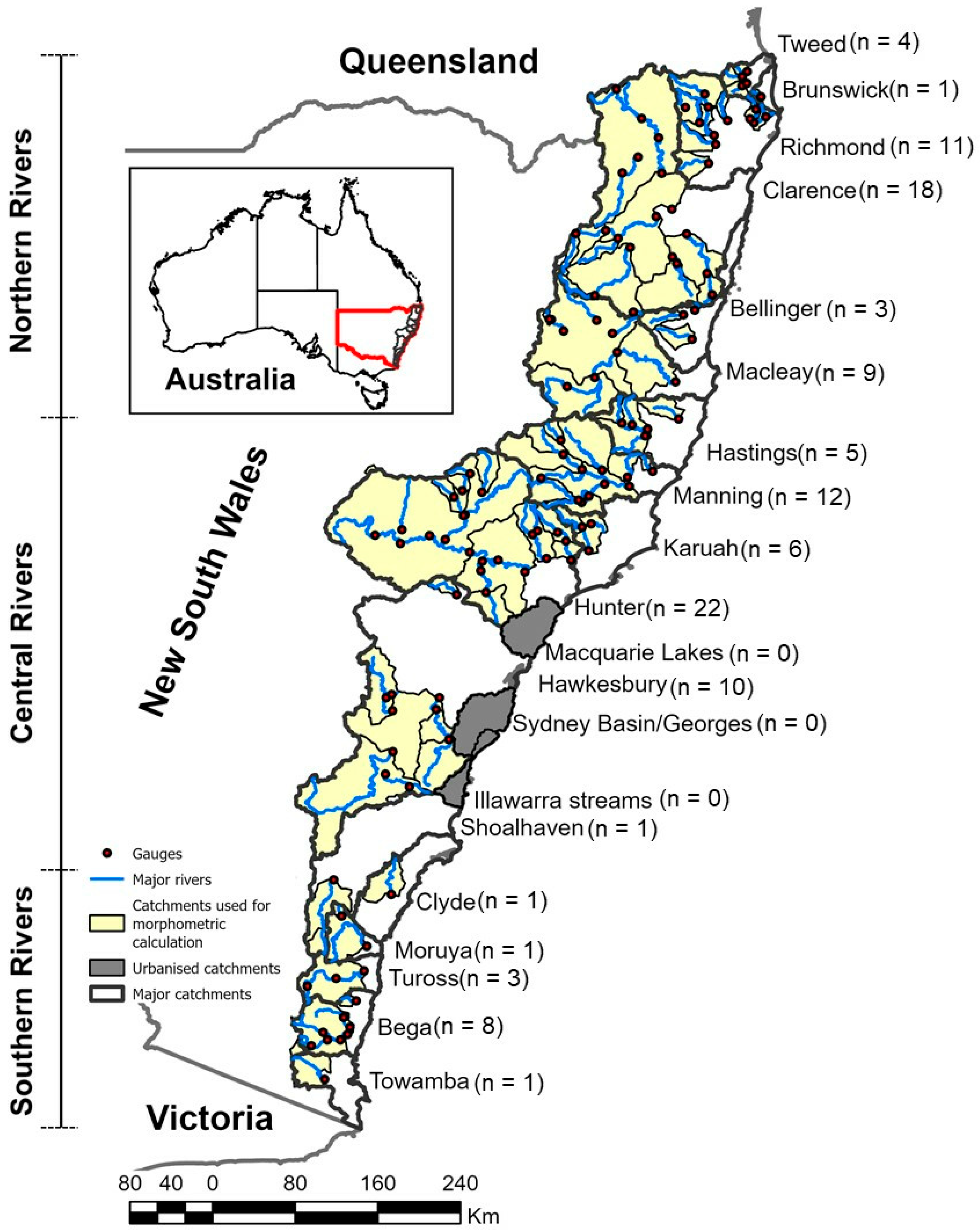
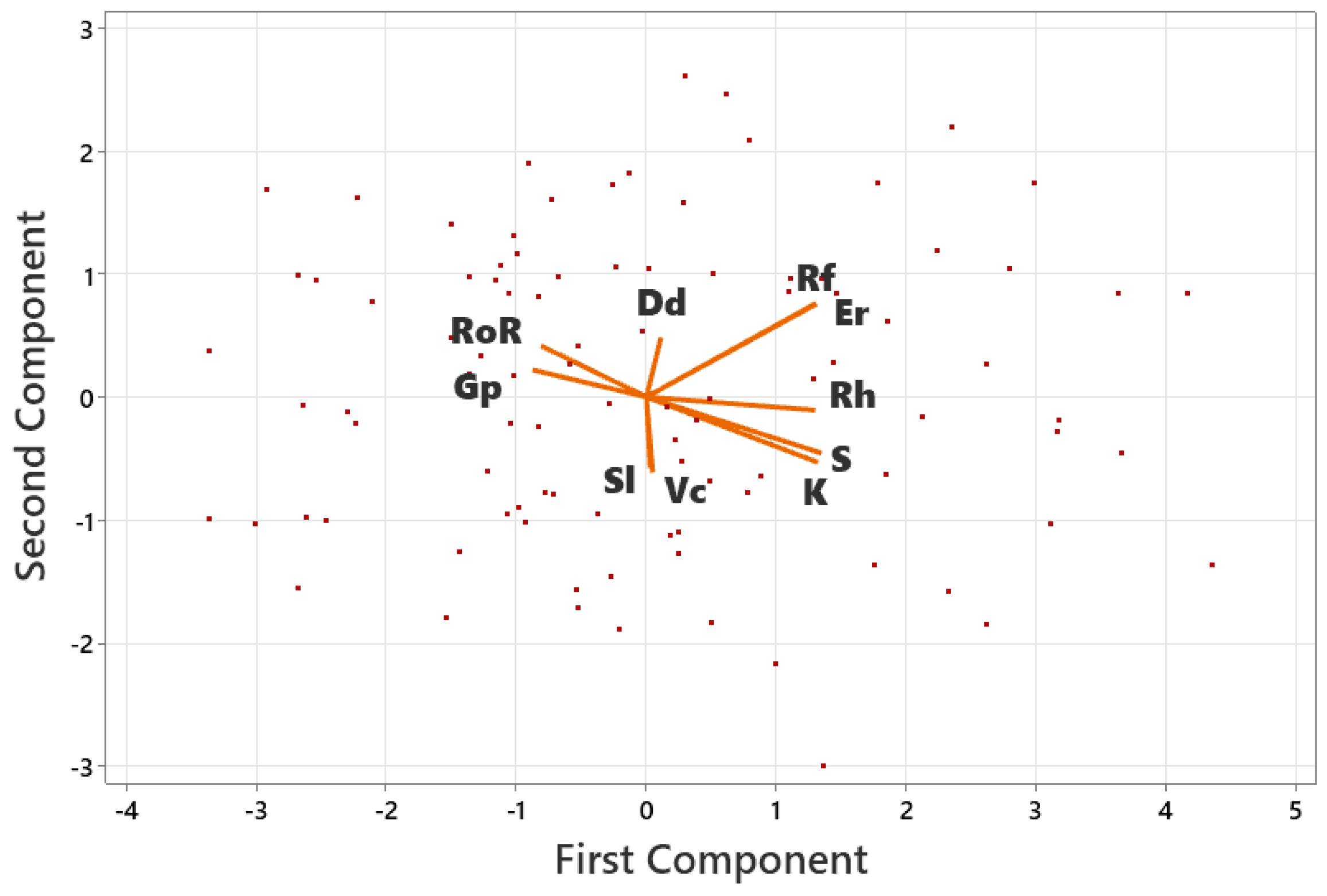
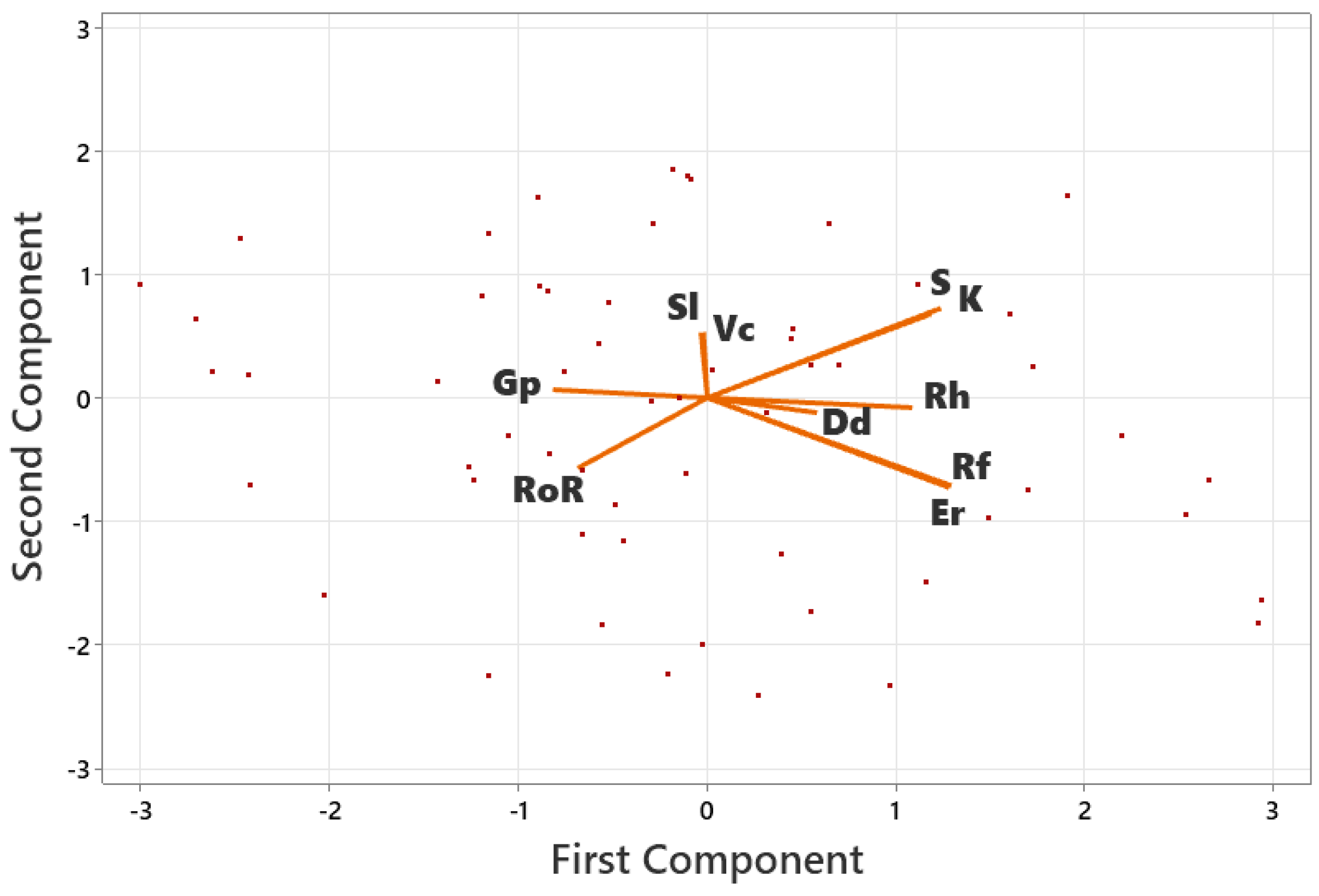
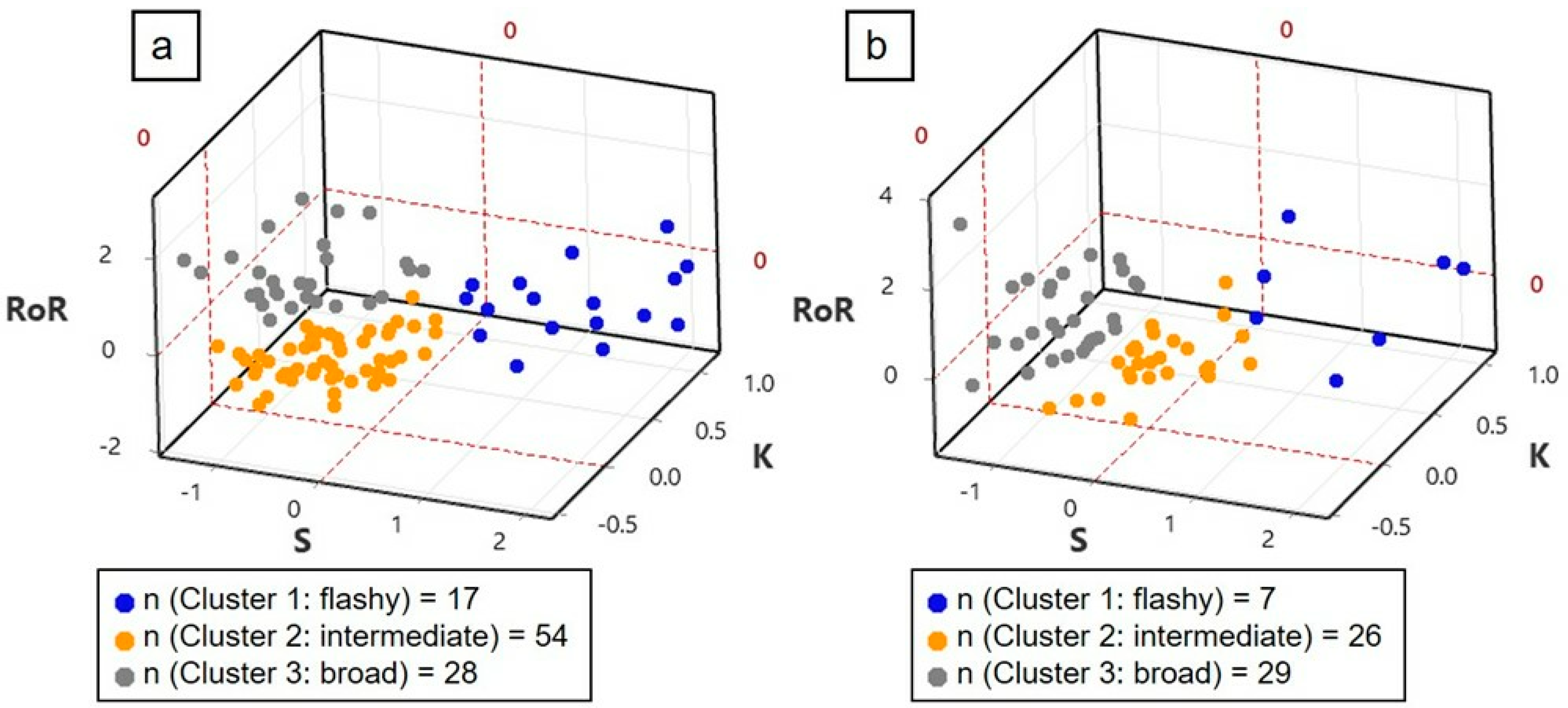
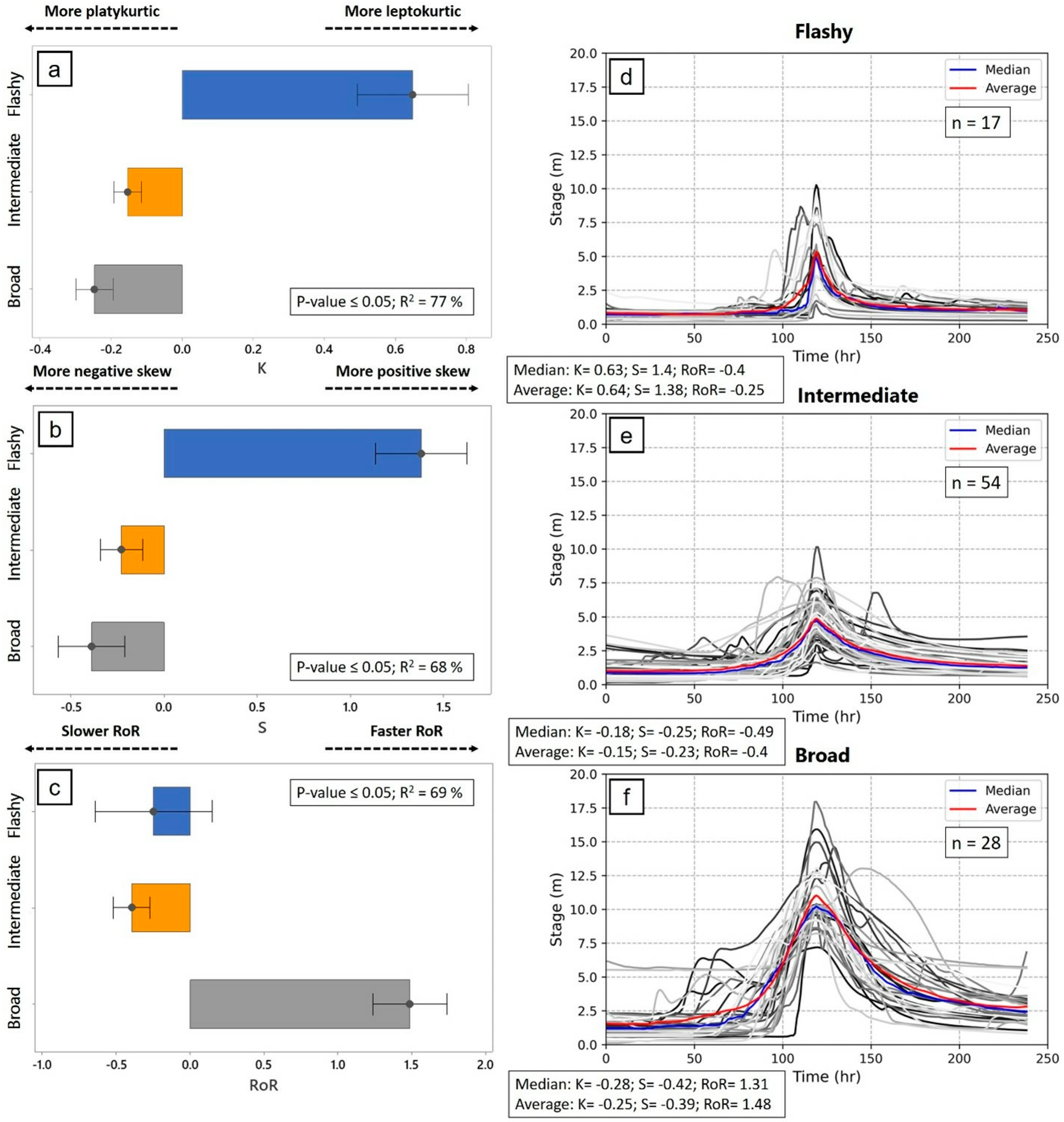
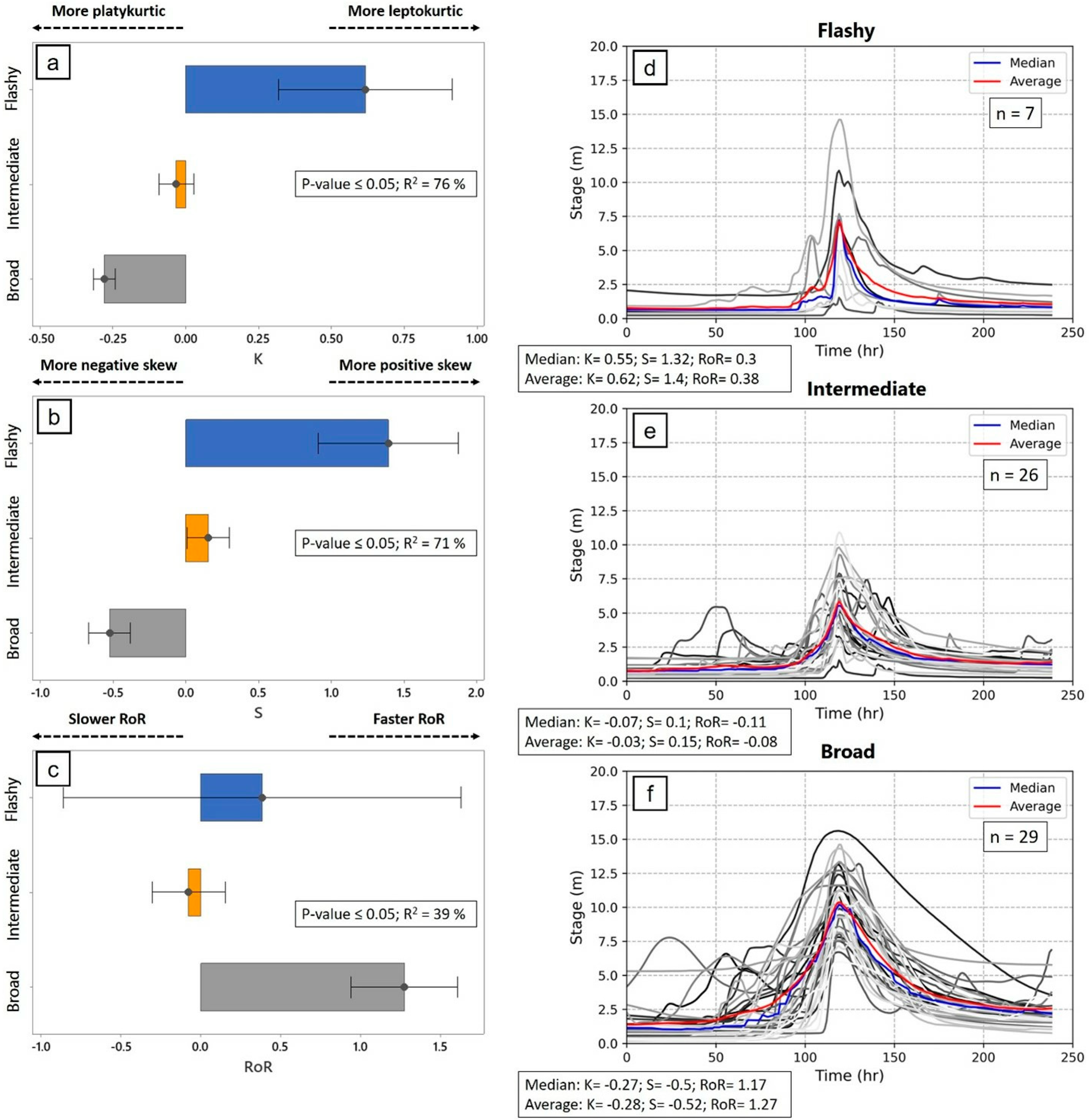

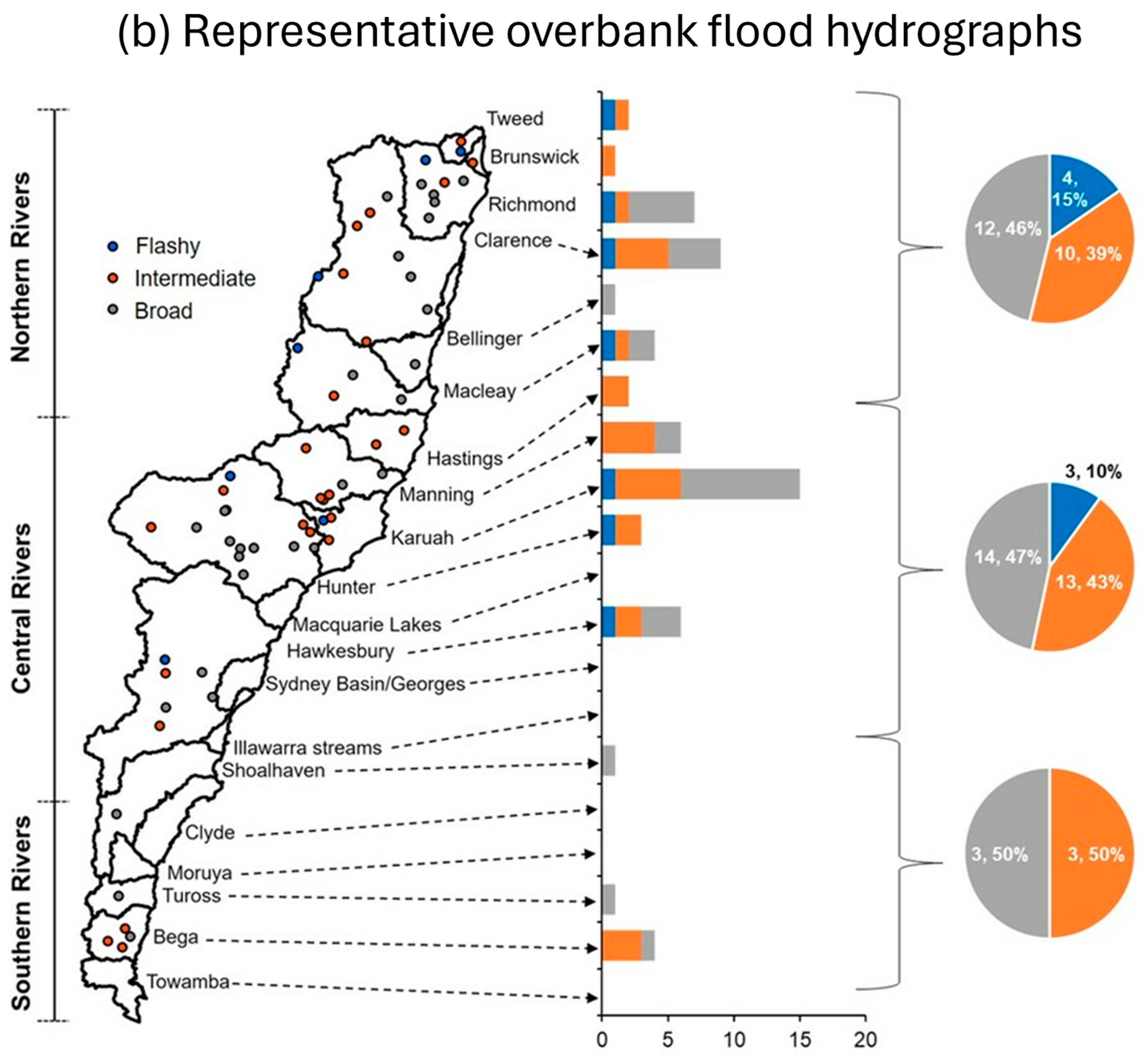

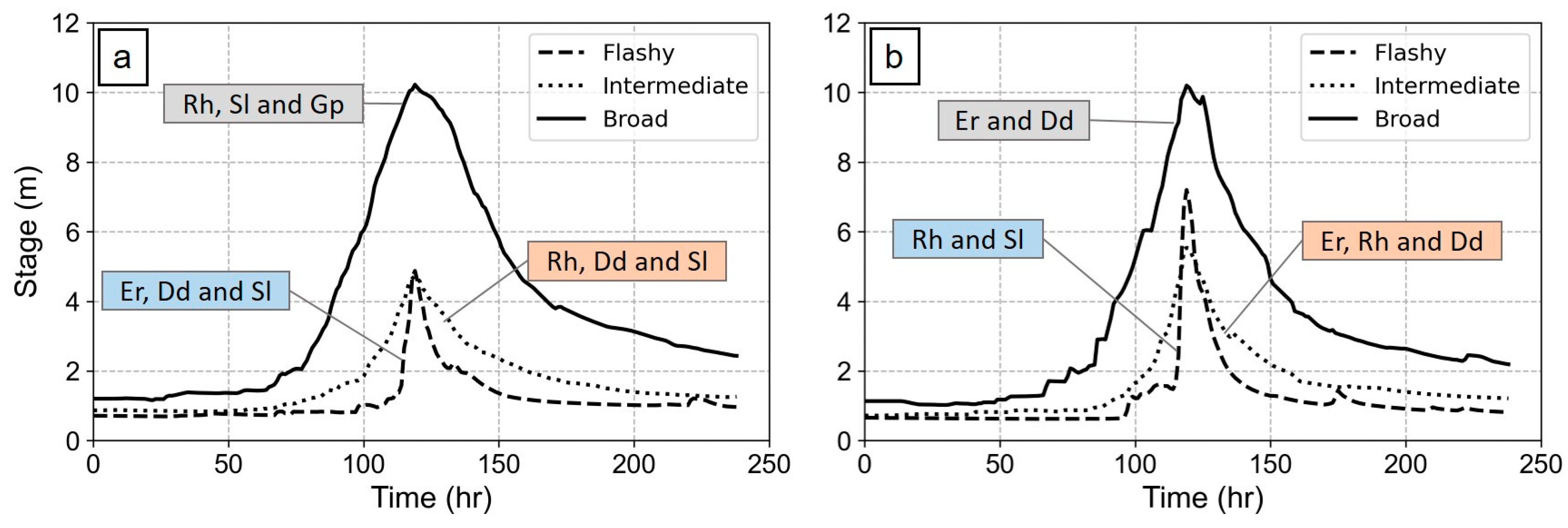
| Metric | Equation | Definition |
|---|---|---|
| Kurtosis (K) | Equation (1) | Measures the ‘tailedness’ of a hydrograph, indicating how peaked or flat the hydrograph is compared to a normal distribution. |
| Skewness (S) | Equation (2) | Indicates the degree of asymmetry in a hydrograph, measuring how much it deviates from being symmetrical. |
| Rate-of-rise (RoR) | Equation (3) | Describes the speed at which water stage rises in a hydrograph. |
| Metric | Equation | Definition | Catchment Characteristics Described |
|---|---|---|---|
| Elongation ratio (Er) | Equation (4) | Represents the shape of a catchment, calculated as the ratio of the diameter of a circle of the same area as the catchment to the maximum catchment length. | Shape |
| Form factor (Rf) | Equation (5) | Quantifies the shape of a catchment, calculated as the ratio of the catchment area to the square of the catchment length. It indicates how circular a catchment is. | Shape |
| Catchment relief (Rh) | Equation (6) | The difference in elevation between the highest and lowest points in a catchment area. | Topography |
| Drainage density (Dd) | Equation (7) | Measures the total length of all channels in a catchment divided by the total area of the catchment. | Drainage network structure |
| Valley confinement at the gauge (Vc) | Equation (8) | Describes how confined or unconfined a channel valley is at the location of a gauge, usually influencing flow characteristics. | Size |
| Longitudinal slope (Sl) | Equations (9) and (10) | The slope or gradient of a channel, typically measured along its longest course. | Topography |
| Gauge position in the catchment (Gp) | Equation (11) | Refers to the location of a gauging station within a catchment, which can influence the observed hydrograph shape. | Size |
| Flood Type | Cluster | PC | Er | Rh | Dd | Sl | Gp | Dominant Controls |
|---|---|---|---|---|---|---|---|---|
| High flow | flashy | 1 | 0.55 (26%) | 0.57 (26%) | 0.41 (19%) | 0.25 (11%) | 0.38 (18%) | Er, Dd and Sl |
| 2 | −0.4 (19%) | 0.15 (7%) | −0.45 (22%) | 0.68 (33%) | 0.4 (19%) | |||
| intermediate | 1 | 0.48 (23%) | 0.59 (29%) | 0.37 (18%) | 0.09 (5%) | −0.53 (26%) | Rh, Dd and Sl | |
| 2 | 0.14 (7%) | 0.34 (17%) | −0.6 (31%) | 0.68 (35%) | 0.2 (10%) | |||
| broad | 1 | 0.57 (30%) | 0.65 (35%) | 0.12 (6%) | 0.06 (3%) | −0.49 (26%) | Rh, Sl and Gp | |
| 2 | −0.01 (0%) | 0.22 (12%) | −0.59 (33%) | 0.74 (41%) | 0.24 (13%) | |||
| Overbank flood | flashy | 1 | 0.52 (24%) | 0.53 (24%) | 0.46 (21%) | 0.31 (14%) | 0.37 (17%) | Rh and Sl |
| 2 | −0.27 (16%) | −0.36 (21%) | 0.13 (8%) | 0.89 (53%) | −0.03 (2%) | |||
| intermediate | 1 | 0.44 (20%) | 0.47 (21%) | 0.57 (26%) | −0.34 (15%) | −0.38 (17%) | Er, Rh and Dd | |
| 2 | −0.55 (25%) | −0.5 (23%) | 0.29 (13%) | −0.39 (18%) | −0.47 (21%) | |||
| broad | 1 | 0.41 (19%) | 0.42 (19%) | 0.36 (16%) | −0.43 (20%) | −0.59 (27%) | Er and Dd | |
| 2 | −0.67 (40%) | −0.11 (6%) | 0.73 (44%) | 0.03 (2%) | −0.13 (8%) |
Disclaimer/Publisher’s Note: The statements, opinions and data contained in all publications are solely those of the individual author(s) and contributor(s) and not of MDPI and/or the editor(s). MDPI and/or the editor(s) disclaim responsibility for any injury to people or property resulting from any ideas, methods, instructions or products referred to in the content. |
© 2025 by the authors. Licensee MDPI, Basel, Switzerland. This article is an open access article distributed under the terms and conditions of the Creative Commons Attribution (CC BY) license (https://creativecommons.org/licenses/by/4.0/).
Share and Cite
Arash, A.M.; Fryirs, K.; Ralph, T.J. Using a Hydro-Morphic Classification of Catchments to Characterise and Explain High Flow and Overbank Flood Behaviour. Geosciences 2025, 15, 141. https://doi.org/10.3390/geosciences15040141
Arash AM, Fryirs K, Ralph TJ. Using a Hydro-Morphic Classification of Catchments to Characterise and Explain High Flow and Overbank Flood Behaviour. Geosciences. 2025; 15(4):141. https://doi.org/10.3390/geosciences15040141
Chicago/Turabian StyleArash, Amir Mohammad, Kirstie Fryirs, and Timothy J. Ralph. 2025. "Using a Hydro-Morphic Classification of Catchments to Characterise and Explain High Flow and Overbank Flood Behaviour" Geosciences 15, no. 4: 141. https://doi.org/10.3390/geosciences15040141
APA StyleArash, A. M., Fryirs, K., & Ralph, T. J. (2025). Using a Hydro-Morphic Classification of Catchments to Characterise and Explain High Flow and Overbank Flood Behaviour. Geosciences, 15(4), 141. https://doi.org/10.3390/geosciences15040141







